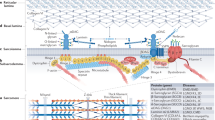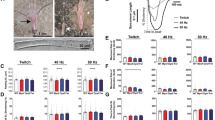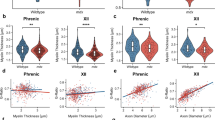Abstract
MUSCULAR dystrophy is a group of inherited diseases of man and animals, characterized by degeneration of skeletal muscles. The condition is usually thought to result from a primary biochemical abnormality of the muscle fibres themselves, but several reports have drawn attention to abnormalities in the motor innervation of dystrophic muscles. In human dystrophies, of either the pseudohypertrophic (Duchenne) or the myotonic types, these findings have included the presence of motor end plates with abnormal appearances1, impaired neuromuscular transmission2, muscle fibre fibrillation potentials3 and diminished motor nerve conduction velocities4 (but see Henricksen5). In the dystrophic mouse there have been reports of abnormal looking end plates6, miniature end plate potentials that were either small7 or reduced in frequency7, and fibrillation potentials9. Moreover, McComas and Mrozek10 have shown that approximately a quarter of the fibres in dystrophic mouse muscle are functionally denervated. In the past, many of these findings have been attributed to secondary changes in the motor nerve cell, particularly in its terminal parts, following muscle fibre degeneration.
This is a preview of subscription content, access via your institution
Access options
Subscribe to this journal
Receive 51 print issues and online access
$199.00 per year
only $3.90 per issue
Buy this article
- Purchase on Springer Link
- Instant access to full article PDF
Prices may be subject to local taxes which are calculated during checkout
Similar content being viewed by others
References
Jedrzejowska, H., Johnson, A. G., and Woolf, A. L., Acta Neuropath., 5, 225 (1965).
Ricker, K., and Mertens, H. G., Electroenceph. Clin. Neurophysiol., 25, 413 (1968).
Norris, F. H., and Chatfield, P. O., Electroenceph. Clin. Neurophysiol., 7, 391 (1955).
Nakao, K., Kito, S., Muro, T., Tomonaga, M., and Mozai, T., Proc. Austral. Assoc. Neurol., 5, 557 (1968).
Henricksen, J. D., thesis, Univ. Minnesota (1956).
Harman, P. J., Tassoni, J. P., Curtis, R. L., and Hollinshead, M., in Muscular Dystrophy in Man and Animals (edit. by Bourne, G. H., and Golarz, M. N.) (Karger, Basle, 1963).
McComas, A. J., and Mossawy, S. J., in Proc. Third Symp. on Research in Muscular Dystrophy (edit. by Muscular Dystrophy Group Research Committee) (Pitmans Medical, London, 1965).
Conrad, J. T., and Glaser, G. H., Arch. Neurol., 11, 310 (1964).
McIntyre, A. R., Bennett, A. L., and Brodkey, J. S., Arch. Neurol. Psychiat., 81 678.
McComas, A. J., and Mrożek, K., J. Neurol. Neurosurg. Psychiat., 30, 526 (1967).
Campbell, M. J., and McComas, A. J., reported in Nature, 225, 316 (1970).
Campbell, M. J., McComas, A. J., and Sica, R. E. P., Proc. Physiol. Soc. (April 1970).
Guth, L., Physiol. Rev., 48, 645 (1968).
Author information
Authors and Affiliations
Rights and permissions
About this article
Cite this article
MCCOMAS, A., SICA, R. & CURRIE, S. Muscular Dystrophy: Evidence for a Neural Factor. Nature 226, 1263–1264 (1970). https://doi.org/10.1038/2261263a0
Received:
Issue Date:
DOI: https://doi.org/10.1038/2261263a0
This article is cited by
-
Progressive muscular dystrophy in a golden retriever dog: light microscope and ultrastructural features at 4 and 8 months
Acta Neuropathologica (1986)
-
Duchenne muscular dystrophy: Pathogenetic aspects and genetic prevention
Human Genetics (1984)
-
Myogenic defect in human muscular dystrophy
Nature (1977)
-
Hypotheses and recent findings concerning aetiology and pathogenesis of the muscular dystrophies
Journal of Neurology (1976)
-
Choline acetyltransferase activity in human muscular diseases
Journal of Neurology (1976)
Comments
By submitting a comment you agree to abide by our Terms and Community Guidelines. If you find something abusive or that does not comply with our terms or guidelines please flag it as inappropriate.



